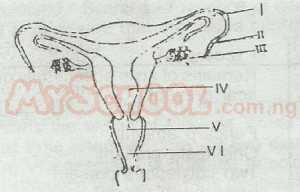Which of the following parasites is a flatworm?
- A. Plasmodium
- B. Trypanosoma
- C. Ascaris
- D. Schistosoma
Which of the following factors may not affect living organisms in an aquatic habitat?
- A. Turbidity
- B. Temperature
- C. Humidity
- D. Light
A situation whereby some mammals remain inactive throughout dry and hot seasons is known as
- A. aestivation
- B. dormancy
- C. burrowing
- D. incubation
Which of the following is a means of measuring primary production?
- A. Rate of reproduction of animals
- B. Life span of an organism
- C. Number of predators in an environment
- D. harvested plants in a unit area
Carbon is added to the atmosphere by the following processes except
- A. respiration
- B. burning
- C. photosynthesis
- D. volcanic eruption
A known weight of soil sample was oven-dried to obtain a constant weight. The loss in weight was due to
loss of
- A. organic matter only
- B. water only
- C. water and organic matter
- D. inorganic matter and water
Soil factors in an ecosystem are referred to as
- A. topographic
- B. climatic
- C. biotic
- D. edaphic
The secchi disc is used to measure
- A. speed of flow of water
- B. specific gravity of water
- C. turbidity of water
- D. depth of water
Desert plants are usually called
- A. hydrophytes
- B. mesophytes
- C. xerophytes
- D. sporophytes
Which of the following is not a biotic factor?
- A. Parasites
- B. Predators
- C. Grazers
- D. Pressure
Which of the following organisms can be found in fresh water habitat?
- A. Sargassum and dog fish
- B. Red mangrove and pond skater
- C. Sargassum and red mangrove
- D. Spirogyra and pond skater
Which of the following statements is true?
- A. Ptyalin acts on proteins to give amino acid
- B. Lactase acts on maltose to give amino acid
- C. Pepsin acts on proteins to give peptide
- D. Peptide acts on starch to give maltose
The dentition of a herbivore is distinct from that of other animals due to the presence of
- A. diastema
- B. cusps on molar teeth
- C. canines
- D. ridges on molar teeth
The importance of a balanced diet is to
- A. maintain constant size of an animal
- B. provide good taste in the food
- C. increase the effectiveness of digestion
- D. provide good health for an individual
In water- culture experiments the culture solutions are protected from sunlight in order to
- A. control the temperature of the culture solution
- B. prevent algae from growing in the solution
- C. prevent the minerals in the solution from being destroyed
- D. allow the minerals to be used up at room temperature
Use the information below on factors required during photosynthesis to answer the two questions
I. CO2 II. Chlorophyll III. Water IV. ATP V NADPH2
The factors required for the dark phase of photosynthesis are
- A. III and IV only
- B. III and V only
- C. III, IV and V only
- D. IV and V only
Use the information below on factors required during photosynthesis to answer the two questions
I. CO2 II. Chlorophyll III. Water IV. ATP V NADPH2
Which of the above factors can be a limiting factor for the process to proceed?
- A. I and II only
- B. I and III only
- C. I and IV only
- D. I, III and IV only
During photosynthesis, light energy is always absorbed by the
- A. shoot
- B. water
- C. chlorophyll
- D. enzyme
Which of the following is not a characteristics feature of a wind dispersed fruit?
- A. Lightweight
- B. winged apparatus
- C. Flossy structure
- D. Buoyancy
During germination of seeds water is taken by the process of
- A. diffusion
- B. hydrolysis
- C. imbibition
- D. translocation

Which of the labelled parts is responsible for the release of ripe ovum?
- A. VI
- B. III
- C. II
- D. I


